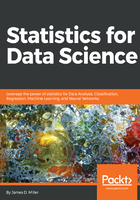
Categorical data
Earlier, we explained how variables in your data can be either independent or dependent. Another type of variable definition is a categorical variable. This type of variable is one that can take on one of a limited, and typically fixed, number of possible values, thus assigning each individual to a particular category.
Often, the collected data's meaning is unclear. Categorical data is a method that a data scientist can use to put meaning to the data.
For example, if a numeric variable is collected (let's say the values found are 4, 10, and 12), the meaning of the variable becomes clear if the values are categorized. Let's suppose that based upon an analysis of how the data was collected, we can group (or categorize) the data by indicating that this data describes university students, and there is the following number of players:
- 4 tennis players
- 10 soccer players
- 12 football players
Now, because we grouped the data into categories, the meaning becomes clear.
Some other examples of categorized data might be individual pet preferences (grouped by the type of pet), or vehicle ownership (grouped by the style of a car owned), and so on.
So, categorical data, as the name suggests, is data grouped into some sort of category or multiple categories. Some data scientists refer to categories as sub-populations of data.